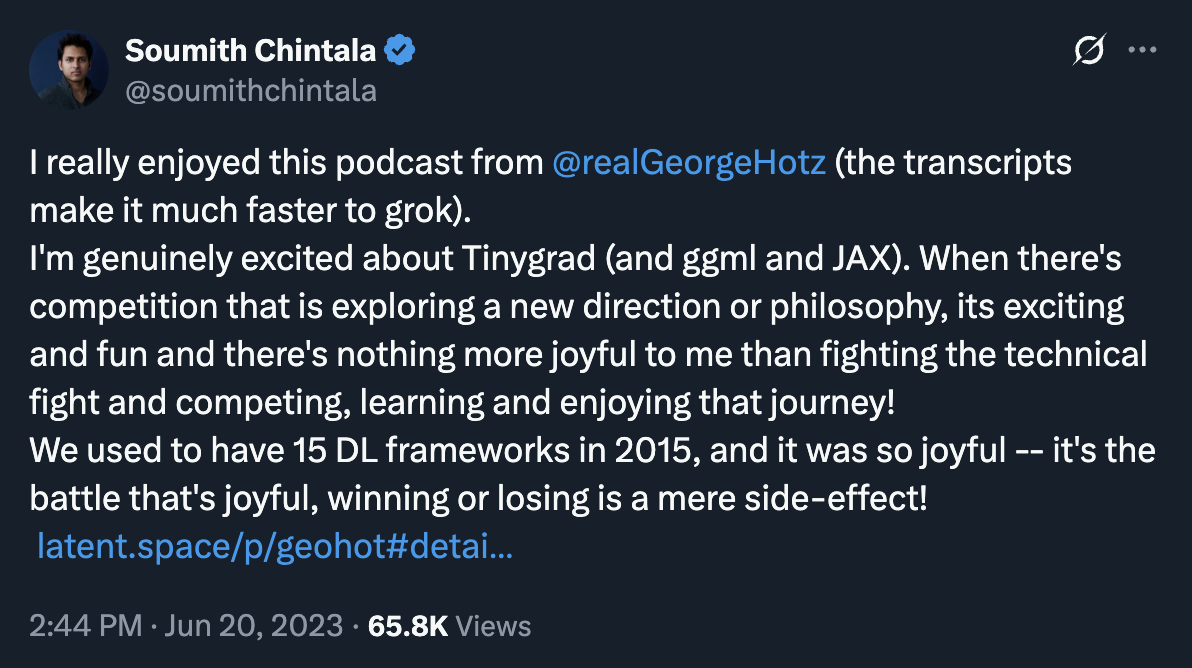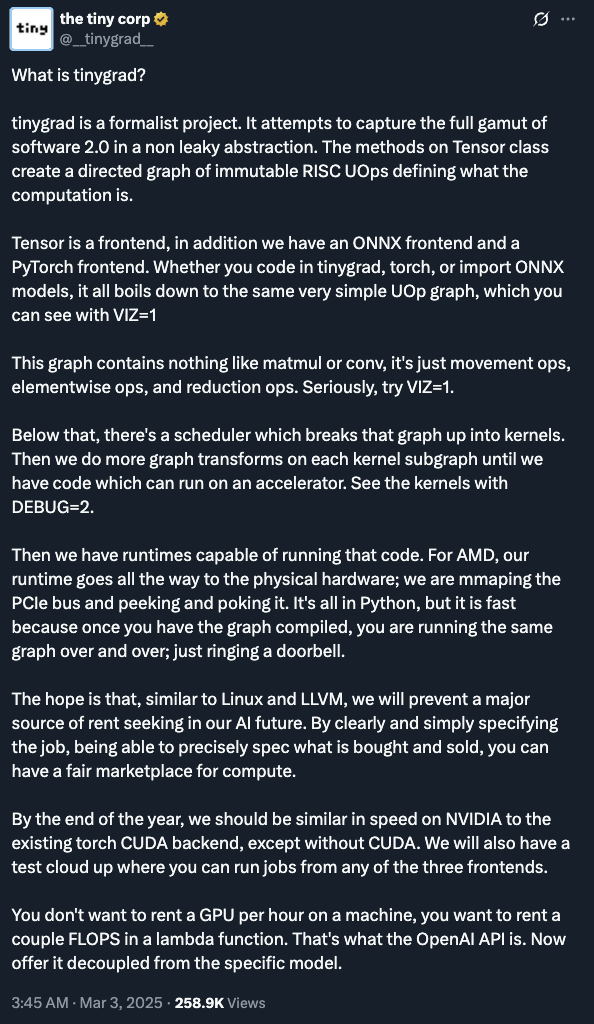
Dreams. Each man longs to pursue his dream. — Guts
Preface: au-197
This chapter introduces the golden age of systems ml and provides a course overview
Golden Age — Software 2.0 Infrastructure Buildout
Throughout the past decade, modern day AI infrastructure has rapidly evolved
to meet the needs of deep neural networks — most notably with the throughput
performance of GPUs moving from TFLOPS to PFLOPS. Datacenter
computing now has the goal of machines with EFLOP speeds, now that that the
throughput of the fastest (non-distributed) supercomputers on TOP500 LINPACK
workloads are just reaching EFLOP levels.
1 second version
SOTA semiconductor physics is forcing both languages and machines to be redesigned from frist principles. This creates a golden age for compiler engineers and computer architects who need to software-hardware codesign the machines of tomorrow.
Welcome to the golden age of Systems ML!
1 minute version
Although the brain is an existence proof of physics powering 20PFLOP machines
with 20W, the problem with the semiconductor physics of today is two-fold:
- instruction-level parallelism from out-of-order superscalar pipelines hits diminishing returns
- frequency scaling is hitting against Dennard scaling's power wall
and so this free-single-thread-performance-lunch aspect to Moore's law that transitioned us across computer classes from minis to micros and from micros to mobile is "over".
As a result computer architects are moving from homogenous general hardware to heterogenous specialized hardware, which means that the complexity of extracting program performance leaks upwards from the hardware — these days, to unlock the full performance of hardware, it's the programmer's responsibility to program the vector processors in multi-core/many-core machines.
The problem with the vector processing of multi-core/many-core machines is two-fold:
- programming model: compilers were sufficiently smart with autovectorization
- execution model: program speedups were bound by Amdahl's law
But the industry sidestepped these problems by changing the programming model to SIMT on SIMD (CUDA) and finding domains whose execution models had more parallelism (deep neural networks).
The challenge (producing a golden age) of compiler engineers and chip architects face is to find the optimal mapping from intelligence to energy. This means creating new programming languages and machiens while minimizing the accidental complexity that naturally builds up along the way:
- The Golden Age of Compiler Design (Lattner)
- A New Golden Age for Computer Architecture (Hennessy and Patterson)
Welcome to the golden age of Systems ML!
10 minute version
The Singularity Systems: Zero to Hero course follows up from
where Neural Networks: Zero to Hero
left off: we will convert micrograd into picrograd, where the main difference is that:
- micrograd is a backprop engine with scalar-support helping researchers understand that backpropagation as an abstraction is in fact leaky (gradient activations, normalizations)
- picograd leans closer towards modern day deep learning frameworks with tensor-support for both pytorch1 interpretation and pytorch2 compilation.
While picograd is more oriented towards low-level system programmers and
performance engineers, this framework remains pedagogical and remains a
point-wise compiler. This means that we will "only" support:
- 3 models: llama, stable diffusion, whisper
- 1 programming model: eager
- 2 execution model: eager, graph
- 2 hardware architectures: amd cpu, nvidia gpu
- 2 precisions: fp32, tf32
The astute reader will point out that besides the unlock of hardware performance itself, the secondary benefit compilers bring to the table is the portability of said-performance. While this is true from theoretical normative perspective, in practice, the industry does not have performance-portability with vector nor tensor programs on vector processors (GPUs) — standing in contrast to scalar programs on scalar processors (CPUs).
Colloquially, the industry's lack of performance-portability is also known as
the cuda moat. This is because the cheapest path to maximize performance
measured in FLOP/S/W or BW/S/W is done with NVIDIA's vector processors, where
the normalizing term of cost denominated in energy also includes the operational
expenditure required to hire kernel engineers for each new A100/H100/B100 generation.
So with that being said, although the gold standard for compiler construction would unlock both 1. performance and 2. performance-portability, given that the industry itself has not even reached the second bar, we will provide ramps to performance-portability by comparsing and contrasting the implementation of picograd to tinygrad, a framework trying to unlock that portability — colloquially known as comoditizing the petaflop.

The core design decision that tinygrad makes in order to differentiate itself from pytorch and friends is bringing back search at the systems level pioneered by halide and tvm. Although many research scientists espouse the "learning and search" wisdom from the Bitter Lesson, the jury is still out whether search works at the systems level given that empirically, it's failed in the past (i.e. the addition of tensor cores to the underlying hardware is one of the main reasons attributed towards tvm's "failure"), and in the present, tinygrad is still underperforming pytorch on NVIDIA hardware.
But even with all that being said with respect to the technical design decisions being made, what's more relevent and compelling to the Singularity Systems course is the philosophical engineering decision tinygrad is making: to surface complexity.
The PyTorch project is 3,327,184 lines of code across 11,449 files while the tinygrad project is 296,447 across 865 files (where source is further limited to 13k lines of code). Assuming PyTorch's non-source/source ratio is in the same ballpark as tinygrad's then this implies there's around 100,000 lines of PyTorch source, and so measured in lines of code in both non-source and source, PyTorch has 10x more complexity than tinygrad.
And so although there does exist this argument that PyTorch provides a more batteries-included experience, using tinygrad's implementation as a case-study is more well-suited to the goals of this course. In all three chapters, we will walk through picograd's implementation, and then compare it to that of tinygrad's.
Welcome to the golden age of Systems ML!

1(0) year version
Although the Singularity Systems course points towards tinygrad as a system attempting to ammend the industry's lack of performance-portability (removing the "cuda moat" by "comoditizing the petaflop"), there are other possible solutions that take a broader view. Rather than building a new framework or domain specific language, perhaps new programming and execution models implemented as new languages and machines for parallel computing should be built.
And this is exactly what companies like Mojo and Tenstorrent are doing — they are re-industrializing research ideas from the unsolved world of parallel computing. The former riffing on ideas from comptime metaprogamming pioneered by Zig, and the latter on ones from CELL/Larabee tensor processing.